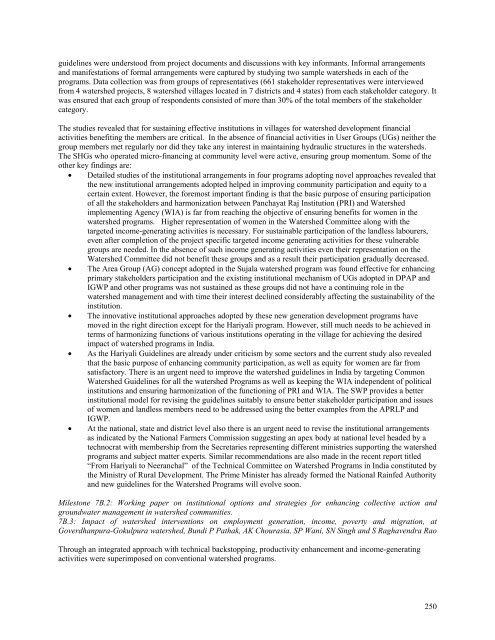ICRISAT Archival Report 2006 - The seedlings of success in the ...
ICRISAT Archival Report 2006 - The seedlings of success in the ...
ICRISAT Archival Report 2006 - The seedlings of success in the ...
Create successful ePaper yourself
Turn your PDF publications into a flip-book with our unique Google optimized e-Paper software.
guidel<strong>in</strong>es were understood from project documents and discussions with key <strong>in</strong>formants. Informal arrangements<br />
and manifestations <strong>of</strong> formal arrangements were captured by study<strong>in</strong>g two sample watersheds <strong>in</strong> each <strong>of</strong> <strong>the</strong><br />
programs. Data collection was from groups <strong>of</strong> representatives (661 stakeholder representatives were <strong>in</strong>terviewed<br />
from 4 watershed projects, 8 watershed villages located <strong>in</strong> 7 districts and 4 states) from each stakeholder category. It<br />
was ensured that each group <strong>of</strong> respondents consisted <strong>of</strong> more than 30% <strong>of</strong> <strong>the</strong> total members <strong>of</strong> <strong>the</strong> stakeholder<br />
category.<br />
<strong>The</strong> studies revealed that for susta<strong>in</strong><strong>in</strong>g effective <strong>in</strong>stitutions <strong>in</strong> villages for watershed development f<strong>in</strong>ancial<br />
activities benefit<strong>in</strong>g <strong>the</strong> members are critical. In <strong>the</strong> absence <strong>of</strong> f<strong>in</strong>ancial activities <strong>in</strong> User Groups (UGs) nei<strong>the</strong>r <strong>the</strong><br />
group members met regularly nor did <strong>the</strong>y take any <strong>in</strong>terest <strong>in</strong> ma<strong>in</strong>ta<strong>in</strong><strong>in</strong>g hydraulic structures <strong>in</strong> <strong>the</strong> watersheds.<br />
<strong>The</strong> SHGs who operated micro-f<strong>in</strong>anc<strong>in</strong>g at community level were active, ensur<strong>in</strong>g group momentum. Some <strong>of</strong> <strong>the</strong><br />
o<strong>the</strong>r key f<strong>in</strong>d<strong>in</strong>gs are:<br />
• Detailed studies <strong>of</strong> <strong>the</strong> <strong>in</strong>stitutional arrangements <strong>in</strong> four programs adopt<strong>in</strong>g novel approaches revealed that<br />
<strong>the</strong> new <strong>in</strong>stitutional arrangements adopted helped <strong>in</strong> improv<strong>in</strong>g community participation and equity to a<br />
certa<strong>in</strong> extent. However, <strong>the</strong> foremost important f<strong>in</strong>d<strong>in</strong>g is that <strong>the</strong> basic purpose <strong>of</strong> ensur<strong>in</strong>g participation<br />
<strong>of</strong> all <strong>the</strong> stakeholders and harmonization between Panchayat Raj Institution (PRI) and Watershed<br />
implement<strong>in</strong>g Agency (WIA) is far from reach<strong>in</strong>g <strong>the</strong> objective <strong>of</strong> ensur<strong>in</strong>g benefits for women <strong>in</strong> <strong>the</strong><br />
watershed programs. Higher representation <strong>of</strong> women <strong>in</strong> <strong>the</strong> Watershed Committee along with <strong>the</strong><br />
targeted <strong>in</strong>come-generat<strong>in</strong>g activities is necessary. For susta<strong>in</strong>able participation <strong>of</strong> <strong>the</strong> landless labourers,<br />
even after completion <strong>of</strong> <strong>the</strong> project specific targeted <strong>in</strong>come generat<strong>in</strong>g activities for <strong>the</strong>se vulnerable<br />
groups are needed. In <strong>the</strong> absence <strong>of</strong> such <strong>in</strong>come generat<strong>in</strong>g activities even <strong>the</strong>ir representation on <strong>the</strong><br />
Watershed Committee did not benefit <strong>the</strong>se groups and as a result <strong>the</strong>ir participation gradually decreased.<br />
• <strong>The</strong> Area Group (AG) concept adopted <strong>in</strong> <strong>the</strong> Sujala watershed program was found effective for enhanc<strong>in</strong>g<br />
primary stakeholders participation and <strong>the</strong> exist<strong>in</strong>g <strong>in</strong>stitutional mechanism <strong>of</strong> UGs adopted <strong>in</strong> DPAP and<br />
IGWP and o<strong>the</strong>r programs was not susta<strong>in</strong>ed as <strong>the</strong>se groups did not have a cont<strong>in</strong>u<strong>in</strong>g role <strong>in</strong> <strong>the</strong><br />
watershed management and with time <strong>the</strong>ir <strong>in</strong>terest decl<strong>in</strong>ed considerably affect<strong>in</strong>g <strong>the</strong> susta<strong>in</strong>ability <strong>of</strong> <strong>the</strong><br />
<strong>in</strong>stitution.<br />
• <strong>The</strong> <strong>in</strong>novative <strong>in</strong>stitutional approaches adopted by <strong>the</strong>se new generation development programs have<br />
moved <strong>in</strong> <strong>the</strong> right direction except for <strong>the</strong> Hariyali program. However, still much needs to be achieved <strong>in</strong><br />
terms <strong>of</strong> harmoniz<strong>in</strong>g functions <strong>of</strong> various <strong>in</strong>stitutions operat<strong>in</strong>g <strong>in</strong> <strong>the</strong> village for achiev<strong>in</strong>g <strong>the</strong> desired<br />
impact <strong>of</strong> watershed programs <strong>in</strong> India.<br />
• As <strong>the</strong> Hariyali Guidel<strong>in</strong>es are already under criticism by some sectors and <strong>the</strong> current study also revealed<br />
that <strong>the</strong> basic purpose <strong>of</strong> enhanc<strong>in</strong>g community participation, as well as equity for women are far from<br />
satisfactory. <strong>The</strong>re is an urgent need to improve <strong>the</strong> watershed guidel<strong>in</strong>es <strong>in</strong> India by target<strong>in</strong>g Common<br />
Watershed Guidel<strong>in</strong>es for all <strong>the</strong> watershed Programs as well as keep<strong>in</strong>g <strong>the</strong> WIA <strong>in</strong>dependent <strong>of</strong> political<br />
<strong>in</strong>stitutions and ensur<strong>in</strong>g harmonization <strong>of</strong> <strong>the</strong> function<strong>in</strong>g <strong>of</strong> PRI and WIA. <strong>The</strong> SWP provides a better<br />
<strong>in</strong>stitutional model for revis<strong>in</strong>g <strong>the</strong> guidel<strong>in</strong>es suitably to ensure better stakeholder participation and issues<br />
<strong>of</strong> women and landless members need to be addressed us<strong>in</strong>g <strong>the</strong> better examples from <strong>the</strong> APRLP and<br />
IGWP.<br />
• At <strong>the</strong> national, state and district level also <strong>the</strong>re is an urgent need to revise <strong>the</strong> <strong>in</strong>stitutional arrangements<br />
as <strong>in</strong>dicated by <strong>the</strong> National Farmers Commission suggest<strong>in</strong>g an apex body at national level headed by a<br />
technocrat with membership from <strong>the</strong> Secretaries represent<strong>in</strong>g different m<strong>in</strong>istries support<strong>in</strong>g <strong>the</strong> watershed<br />
programs and subject matter experts. Similar recommendations are also made <strong>in</strong> <strong>the</strong> recent report titled<br />
“From Hariyali to Neeranchal” <strong>of</strong> <strong>the</strong> Technical Committee on Watershed Programs <strong>in</strong> India constituted by<br />
<strong>the</strong> M<strong>in</strong>istry <strong>of</strong> Rural Development. <strong>The</strong> Prime M<strong>in</strong>ister has already formed <strong>the</strong> National Ra<strong>in</strong>fed Authority<br />
and new guidel<strong>in</strong>es for <strong>the</strong> Watershed Programs will evolve soon.<br />
Milestone 7B.2: Work<strong>in</strong>g paper on <strong>in</strong>stitutional options and strategies for enhanc<strong>in</strong>g collective action and<br />
groundwater management <strong>in</strong> watershed communities.<br />
7B.3: Impact <strong>of</strong> watershed <strong>in</strong>terventions on employment generation, <strong>in</strong>come, poverty and migration, at<br />
Goverdhanpura-Gokulpura watershed, Bundi P Pathak, AK Chourasia, SP Wani, SN S<strong>in</strong>gh and S Raghavendra Rao<br />
Through an <strong>in</strong>tegrated approach with technical backstopp<strong>in</strong>g, productivity enhancement and <strong>in</strong>come-generat<strong>in</strong>g<br />
activities were superimposed on conventional watershed programs.<br />
250

















